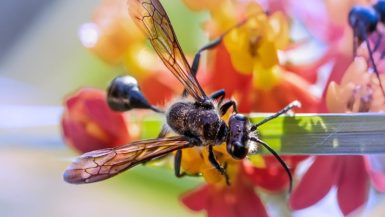
When you think of England’s rolling hills, the wave-washed Welsh coast, the Scottish highlands, and the green farms of Northern Ireland, you probably don’t think of potentially harmful critters. Mhmm…Blighty may not be home to the lions, tigers, and bears of more exotic climbs, at least not outside of its award-winning zoos, but there are actually quite a few dangerous animals in the UK that you might want to be cautious of as you travel these old isles.
The thing is, rambling through the countryside is one of the best ways to take in Britain’s natural beauty. There’s lots of fauna to see, to the tune of over 70,000 different species, no less. Most of those pose no threat to humans at all. But there are some, a few unsuspecting predators and would-be dangers, lying in wait….
From creepy crawlies carrying deadly diseases to the unlikely hazards of the farmyard animals that populate Britain’s fields, this guide takes a closer look at nine of the most dangerous animals in the UK that you should keep an eye out for. Whether you’re touring the epic beaches or hiking the Highlands, bear these ones in mind at all times.
Bees, wasps, and hornets

There are 240 different species of bees in the UK, and they are a crucial part of the British ecosystem. Bees move pollen from one plant to another, fertilizing food crops to yield grains, vegetables, and seeds. Bee populations are at risk in the UK, though, so these guys really should be protected rather than feared. But bees and their flying counterparts can be dangerous.
Bees belong to the Hymenoptera insect group, along with wasps and hornets, and around five to 12 people die every year in the UK from stings delivered by that genus. The sharp pinprick sensation, often described as a hot needle piercing the skin, can cause instant burning, irritation, swelling, and redness. In most cases the pain will subside in a few hours without any issues.
It’s when the stings lead to complications like anaphylactic shock that things can get dangerous. This reaction causes the body to go into shutdown, and the throat and lungs can swell, blocking the airways and resulting in suffocation. Thankfully, this can be treated with immediate epinephrine administration, but you will likely need to seek out professional medical attention to get it sorted.
Ticks

Ticks are barely the size of a pinhead but they’re one of the most dangerous and silent killers in the UK. The bijou bugs are identifiable by their bulbous thorax and needle-like pincers. Although their bites are often undetectable, ticks are bloodsucking creatures that latch on to human skin as well as farmyard animals, cats, and dogs. But it is not their bites that are deadly. Instead, it’s the diseases they can carry that make them something to be feared.
Ticks are responsible for the majority of insect-transmitted Lyme Disease cases. They are thought to cause more than eight people to catch the disease every single day in the UK alone. Lyme Disease is a common vector-borne illness that leads to joint swelling, cognitive issues, and, in extreme cases heart attacks. Most patients can be treated in a few weeks. Still, some patients with advanced Lyme Disease can feel symptoms for several years, suffering from fatigue, rashes, arthritis, and even partial paralysis.
Luckily, not all ticks carry the disease. But that doesn’t mean you shouldn’t be watchful against all ticks to prevent bites from those that do. Ticks lurk in farmland, woodland, fields, and even your back garden, usually waiting in long grass for unsuspecting prey. Ticks will leap onto anything that brushes past them and quickly attach themselves to moist skin. It’s best to keep your legs and ankles covered whenever you’re venturing through the UK countryside, especially in the warmer months when these bugs are more prevalent. It’s also a good idea to carry a pair of tweezers or a dedicated tick removal tool just in case you spot one.
Adders

We hate to break it to you, but the UK does have venomous snakes: Adders. These formidable-looking serpents are actually a member of the much-feared viper family. They are found in three of the four home nations – Wales, Scotland, and England – but not in Ireland. That’s the bad news. The good news is that bites are rare, with less than 100 incidents recorded on an average year.
Still, it’s not something you should dismiss. Adder bites can be fatal, with an estimated 14 fatalities since records began in the late 19th century. Envenomation from these guys can be bad, with symptoms like intense pain at the site of contact, extreme swelling, and blood blisters forming immediately after the bite.
It’s important to keep all this in perspective, though: The UK has seen under 15 deaths in over 150 years! That’s low considering the prevalence of adders across the country, especially during their main mating seasons in the spring and summer months, which often brings them into contact with hikers and beach goers.
Weever fish

Jellyfish are responsible for more stings than any other marine animal in the UK. But British species are mainly harmless, and jellyfish cannot be provoked. On the other hand, weever fish are the only poisonous fish in the UK. They’re usually small and often undetectable, but their presence is becoming increasingly common on Britain’s sandy beaches.
Found all over Europe, weever fish populate the shores off Cornwall, the Irish coast, the Welsh coast, and even Dorset and Bournemouth. The venom in the spine of weever fish contains a chemical with one of the most pain-inducing potencies known to man. Dwelling close to shorelines, most weever fish stings occur when the creature is stepped on, as they like to burrow into sand and muddy shallows.
Weever fish are also aggressive and have been known to strike swimmers and divers. Even when dead, their needle-like spines produce the neurotoxin venom capable of hurting swimmers and surfers. Weever fish stings are excruciatingly painful but don’t often cause long-term symptoms. Still, they have been known to trigger heart attacks and even severe swelling. Treatments often include submerging the wound in high-temperature water for up to an hour after the bite.
Deer

Deer are known for being timid, modest, and elegant creatures. Deers run from danger, avoid humans, and are uncomfortable with anything removed from their peaceful country lives. You might have thought that the only time deers would make you cry is when watching Bambi! But, believe it or not, they cause more road accidents than any other mammal in the UK so can certainly be a potential danger.
Yep, although you’d struggle to aggravate these gentle giants, deer are linked to around 50,000 traffic collisions and 20 road-related deaths every year in the UK. They usually live peacefully in fields and woodland, but stray deer are easily spooked and often make their way onto roads, suddenly appearing and leaving little time for drivers to react, especially at night.
Look, we’re not saying you need to run for the hills if you see a deer in the wild, but you should always be cautious on country lanes, especially when its dark or there’s ice on the road. Make sure you also look out for signposts alerting to the presence of deer. These usually signify that wild deer-related road incidents have occurred in the past or that deer are farmed nearby.
Hairy caterpillars

However harmless these colorful little furry creatures can look, hairy caterpillars are a nuisance in the British summer. They are not to be underestimated, coming armed with barbed and venomous hairs that can trigger asthma, vomiting, rashes, and swelling. Yep – these cute little critters!
The hair on these fascinating fluffy insects is called setae. Although it won’t kill you, the overactive immune response they trigger in most people will not be pleasant. The inflammation, itching, welts, and even vesicles, which are fluid-filled sacs caused on the skin’s surface, can take some time to subside and even have long-term effects.
Hairy caterpillars can be present in large numbers during the warmer months of the UK, and you won’t have to venture far to come across them – the bottom of the garden is usually far enough. Nature has a funny way of warning off predators, and bright colors are usually a good indication of venom. The same goes for spikes, hair, and pronounced pincers that seemingly harmless British insects might boast. It’s just a good idea to keep your distance from any exotic insect you spot in your back garden to avoid unwanted bites and stings that can lead to further complications.
Noble false widow

Arachnophobes have some good and some bad news to deal with here. First, the good: The noble false widow spider isn’t as bad as the infamous black widow spiders that inspire fear around the globe. They’re much less dangerous than that. Now, the bad news: These guys are still venomous and are considered the only spider species that can cause a painful bite in humans.
Yep, they carry a toxin- and serine-based venom that’s similar but less potent than their black widow counterparts. It’s capable of inflicting pain much like a wasp or bee sting in human victims and can lead to complications such as fever, face flushing, tiredness, and swelling at the site of contact.
It’s also worth noting that noble false widows are thought to be on the rise in the UK. As global warming reduces the severity of winters in Scotland and northern counties like Yorkshire, their numbers have been increasing in areas where they previously weren’t found at all. So, be on the lookout for their long brown legs and bulbous and pattered pedipalps back.
Portuguese Man o’ War

The Portuguese Man o’ War is every British surfer’s nightmare sight. You’re off to hit the perfect beach breaks of Newquay or about to paddle out in Pembrokeshire, and there they are, dotting the beach from top to bottom. You won’t miss em’ – the Portuguese Man o’ War come with strange purple-pink coloring on top and a dangling mass of tentacles that turn a deep bluish mauve beneath. Let’s put it another way: The look like an alien!
These curious sea creatures are rare in the UK. They only wash up on the beaches of the west and south coast a few times each season. But that’s hard to predict since they have no means of propulsion of their own and are brought in by winds and swells from further south in Europe. They’re also not exactly what they seem. Not a jellyfish, but a hydrozoan, which means each Man o’ War is actually a colony of millions of much smaller organizims working in unison.
Now…the sting. The long – sometimes more than a whole meter! – tentacles of these bad boys hold a nasty venom that can paralyze small fish and cause extreme pain in humans. The most dangerous cases are when the venom reaches all the way to the lymph nodes, which can cause paralysis shock, and even death!
Cows

Topping off this list is the animal that consistently tops the bill in the UK as the most common and most farmed. But believe it or not, cows are also the most dangerous animals in the UK. Here’s why…
Cows are largely docile creatures and can be found grazing and lazing in farmed herds all across the country. But, recent studies have found that cattle have been responsible for 74 deaths in the past 15 years, averaging at three a year, making cows potentially the most deadly animal in the whole of Britain. This number is far more than the deaths caused by dogs, for example, which sits at just over 17 in the same time frame!
You might also be wondering why these stats make cows more dangerous than deer, even though they cause considerably fewer fatalities a year. This is because cows have caused more active deaths than any other mammal in the UK, known to actually charge and kick humans when provoked, leading to severe injury.
Female cows have an instinctive maternal nature and are very protective of their young. As the most farmed animals in the UK, it’s not uncommon for ramblers to stumble across newborn calves and territorial cows in the countryside. You can avoid most unwelcome situations easily by giving cows a wide berth, keeping dogs on leads, and slowly and calmly removing yourself from hostile situations with cattle. Still, considering there are 10 million cows in Britain, rare incidents of injury are bound to occur.
What is the deadliest animal in the UK?
Britain isn’t known for its deadly creatures, but of the 70,000 species of animal in the UK, there are some potentially dangerous ones to look out for. European adders, hairy caterpillars, and weever fish are among the few poisonous creatures found across the country. Their venom is known to cause severe swelling, allergic reactions, and even fatalities in rare cases. Smaller insects like ticks are also big disease spreaders of Lyme Disease, Anaplasma, and Q-fever that can lead to long-term health complications.
Still, the most deadly animals in the UK may come as a surprise, with deer and cows causing more fatalities than any other creature across Britain. Deer are responsible for 50,000 road accidents every year, while cows actively cause around three deaths a year, because they can kick, charge, and even stampede in herds. Altercations with the UK’s large cow population are easy to avoid, so long as you stick to marked paths, keep dogs under control, and stay away from new-born young.
Are there any predators in the UK?
There are several apex predators in the UK that pose little threat to humans but are lethal to their prey. Foxes, otters, owls, and eagles are among such species, and the UK’s waters are even home to a number of sharks that routinely hunt fish and seal populations. The largest land predator in the UK is the humble badger. Being nocturnal and timid, humans rarely encounter these creatures and usually don’t need to exercise caution around them. Still, they typically weigh 12kg and measure 90 cm in length, making them formidable opponents to their unsuspecting prey of frogs, rodents, small birds, and earthworms.
Are there wolves in the UK?
There are no wild wolves in England anymore, though they used to populate woodland and shrubland in large numbers around 10,000 years ago at the end of the last Ice Age. Wolves survived in Scotland until the 18th century, and sightings were reported as late as 1888. There are several wildlife parks in the highlands with controlled wolf populations where visitors can observe them in their natural habitat from a safe distance. Despite some assumptions, wolves are not being reintroduced in Scotland.


